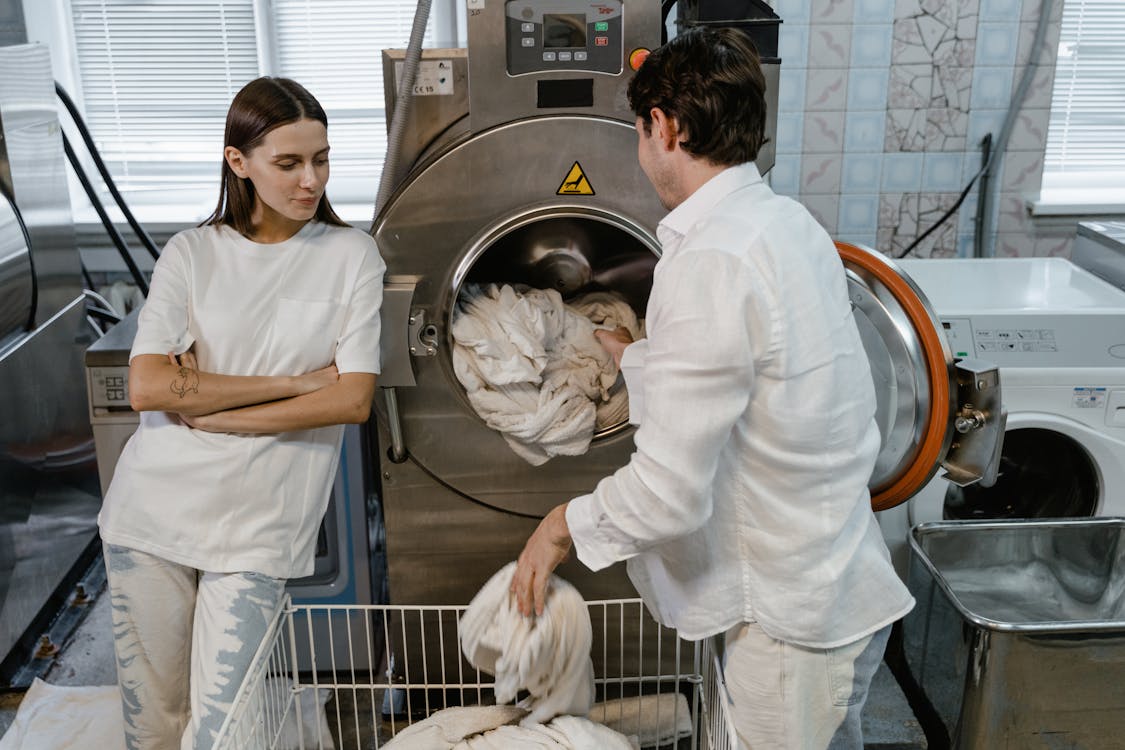How Long Does Dry Cleaning Take: Timeframes and Expectations
Waiting for your garments to be cleaned and ready for wear can feel like forever, especially when you have a busy schedule. So, just how long does dry cleaning take really before you can pickup your garments or have them delivered?
While it’s reasonable to expect timely service from professional dry cleaners, it’s also important to realize that some factors, such as stain removal and fabric type, may require additional time for proper care. If you have a pressing need for quick turnaround, consider discussing your requirements with the dry cleaner and exploring any rush service options they may offer.
If waiting around isn’t something you want to do, then make sure to keep reading this article. We’ll cover everything you need to know about how long does it take for your clothes to be at your local dry cleaners and the factors that affect the turnaround time.
The Dry Cleaning Process and How It Affects Turnaround Time
Understanding how dry cleaning works is crucial to estimating how long it will take to dry clean your garments. The intricacies of this process have a significant impact on the timeframes you can expect. Let’s break it down step by step:
Step 1: Drop-off – You take your clothing items to the dry cleaner’s shop. At this stage, the attendant may provide you with a ticket that includes an estimated pickup date.
Step 2: Inspection – Your garments are inspected for stains, damages, and any special care instructions. This step helps the dry cleaner determine the appropriate treatment.
Step 3: Cleaning – The garments are placed in a specialized dry cleaning machine. A chemical solvent is used to remove stains and dirt effectively.
Step 4: Pressing – After cleaning, your clothes may be pressed or steamed to restore their shape and appearance.
Step 5: Quality Control – A final inspection is conducted to ensure that the items meet the desired standards of cleanliness and appearance.
Step 6: Packaging – Your clean garments are then packaged and prepared for pickup or delivery.
How Long Does Dry Cleaning Take for Different Garments?
You must know that some garments that take longer to dry clean. The turnaround time for many dry cleaners can vary significantly depending on the type of garments you’re entrusting to the process. Here’s a breakdown of how long it generally takes for different types of clothing:
1. Standard Clothing
Everyday items like dress shirts, blouses, and trousers typically have a relatively quick turnaround time. You can expect these garments to be ready in approximately 1 to 2 days. They are relatively simple to clean and require less processing time.
2. Delicate or Special Garments
Garments with delicate fabrics, intricate details, or embellishments, such as beading or sequins, may take a bit longer to clean. They typically take 3 to 4 days or even more, depending on the complexity of the piece and the care it demands.
3. Comforters and Large Items
Bedding items like comforters and duvets are larger and more complex to clean. Due to their size, they may take up to a week to be thoroughly cleaned and prepared for pickup.
4. Wedding Dress
A wedding dress is often a cherished and intricate garment. Due to its elaborate design, delicate fabrics, and potential for stains, cleaning and preserving a wedding dress can be a meticulous process. On average, you can expect a wedding dress to take anywhere from a few days to a couple of weeks to be fully cleaned and prepared for storage or preservation.
5. Formal Suit
Formal suits, like tuxedos or tailored suits, are typically made from high-quality materials and may have unique care requirements. Dry cleaning of these garments may take around 3 to 5 days, although it can vary based on the specific suit’s complexity and fabric.
6. Leather & Suede Items
Leather and suede items, such as jackets or skirts, are not as common in dry cleaning but can be processed by specialized cleaners. Due to the careful handling required for these materials, the turnaround time may be a bit longer, ranging from 1 to 2 weeks.
Time Estimates When Dry Cleaning at Home
Dry cleaning at home has become a convenient option for those who prefer to take matters into their own hands. Using home dry cleaning kits, you can freshen up your garments without the need for professional dry cleaning services. But wondering how long does it take, and what can you expect from this DIY approach?
Home dry cleaning kits typically come with clear instructions, and the process usually involves these steps:
1. Pre-Treatment: Before placing your garments in the provided bag, you’ll need to pre-treat any visible stains. This step can take a few minutes to ensure you address stains adequately.
2. Loading the Bag: After pre-treatment, you place your clothing items into the provided bag along with a cleaning sheet or cloth that contains a specialized dry cleaning solvent.
3. Tumble Drying: The bag is then sealed, and you put it in your dryer. The dryer’s heat activates the cleaning solution, and the bag’s tumbling action helps remove dirt and odors from your clothes.
4. Post-Treatment: Once the cycle is complete, you’ll typically need to let the garments sit for a short period to allow any remaining cleaning agents to dissipate.
The entire process usually takes about 30 minutes to an hour, depending on the specific kit you’re using and your dryer’s settings. It’s a relatively quick method compared to professional dry cleaning, making it a convenient option for those who need their clothing refreshed in a hurry.
However, it’s important to note that home dry cleaning kits may not be as effective as professional dry cleaning for certain garments or stains. While they’re suitable for everyday clothing maintenance, more delicate or heavily soiled items may still require the care of a professional dry cleaner.
Other Reasons You Might Wait Longer for Your Dry Cleaning
While dry cleaning services aim for efficiency, there are various factors that can lead to extended wait times for your garments. Here are some other reasons you might experience delays:
1. Holidays: During holidays, many people take the opportunity to have their special occasion clothing cleaned or refreshed. This increased demand can result in longer processing times as dry cleaners work to accommodate the surge in orders.
2. Big Local Events: When a significant local event, like a wedding expo, fashion show, or convention, takes place in your area, local dry cleaners may experience a higher volume of customers. Such events can lead to delays, especially if attendees require dry cleaning services for their event attire.
3. Extremely Soiled Clothes: Garments that are exceptionally soiled or stained may require additional time and attention. Dry cleaners will need to treat and clean these items meticulously to ensure stains are fully removed, which can extend the overall cleaning process.
4. Dropping Off Laundry at the End of a Workday: Timing matters when it comes to dry cleaning. Dropping off your laundry at the end of a workday, when many others are also trying to pick up or drop off their clothing, can result in longer wait times due to the increased foot traffic and demands on the dry cleaner’s staff.
Items You Can’t Dry Clean
While dry cleaning is a versatile method for cleaning various garments and textiles, there are some items that should never be subjected to this process. Attempting to dry clean these items can lead to irreversible damage. Here’s a list of items you should avoid dry cleaning:
- Fur: Fur garments and accessories should never be dry cleaned. The process can strip the fur of its natural oils and cause it to become brittle and damaged. Fur items require specialized care from furriers.
- Antique or Fragile Fabrics: Antique textiles, delicate silk, and fragile fabrics should not be dry cleaned. The chemicals used in the process can weaken the fibers, leading to irreparable damage. Instead, consult with a textile conservator for appropriate care.
- Items with Glued Elements: Clothing or accessories with glued elements, such as glued-on appliqués or embellishments, should be handled with caution. Dry cleaning can weaken or dissolve the adhesive, causing these elements to detach.
Proper Ways to Store Dry-Cleaned Items
Storing your dry-cleaned items correctly is crucial to ensure they remain in pristine condition. Follow these best practices to keep your garments fresh and ready to wear:
- Use Breathable Garment Bags: Invest in breathable garment bags made of natural materials like cotton. These bags allow air to circulate, preventing moisture buildup and allowing your clothes to breathe.
- Avoid Plastic Covers: Never store dry-cleaned items in plastic covers or bags for extended periods. Plastic can trap moisture, leading to musty odors and potential fabric damage.
- Opt for Cedar or Lavender Sachets: Place cedar or lavender sachets in your storage area. These natural remedies not only deter moths but also provide a pleasant scent, keeping your clothes smelling fresh.
- Choose a Cool, Dark Location: Store your dry-cleaned items in a cool, dark place away from direct sunlight. Sunlight exposure can cause colors to fade and fabrics to deteriorate over time.
- Use Padded Hangers: Hang your dry-cleaned garments on padded hangers to maintain their shape and prevent creases. Wire hangers can cause deformations and wrinkles.
- Use Acid-Free Tissue Paper: When folding garments, place acid-free tissue paper between folds to prevent creases and protect the fabric.
Frequently Asked Questions
Q: Do clothes last longer if dry cleaned?
A: Dry cleaning can extend the lifespan of certain clothing items. Unlike regular washing machines, dry cleaning doesn’t involve water, which can be harsh on delicate fabrics and cause shrinking, fading, or stretching. Dry cleaning uses a gentle solvent that helps preserve the color, shape, and overall quality of your garments. However, not all clothing needs dry cleaning. Everyday wear like t-shirts and jeans can typically be laundered at home, while items like suits, formal dresses, and delicate fabrics benefit from dry cleaning to maintain their longevity.
Q: How long does a dry cleaner have to keep clothes?
A: The duration a dry cleaner keeps clothes can vary by location and local regulations. In many places, dry cleaners are required to keep unclaimed garments for a specific period, often ranging from 30 to 90 days. After this period, they may choose to donate, sell, or dispose of the unclaimed items. It’s essential to check with your specific dry cleaner for their policies and the timeframe they adhere to for storing unclaimed garments.
Q: How powerful is dry cleaning?
A: Dry cleaning is a highly effective method for removing stains, dirt, and odors from clothing. It employs specialized solvents and equipment designed to gently clean and refresh garments without the use of water. Dry cleaning is particularly efficient at tackling oil-based stains and maintaining the quality of delicate fabrics. However, its power depends on the expertise of the dry cleaner and the care taken during the process.
Q: What happens if I wash dry clean only?
A: Washing a garment labeled that says “dry clean only” in a regular washing machine can result in various issues. Water can cause shrinkage, color fading, and distortion of the fabric, leading to irreversible damage. Additionally, some delicate fabrics may not withstand the agitation of a washing machine. It’s generally best to follow care instructions and have “dry clean only” items professionally cleaned to ensure they maintain their appearance and integrity. Attempting to wash them at home can lead to costly repairs or replacements.









0 Comments